On the second day of Cinefest, EFSP presents Rudolf Meyer (1901-1969). During the 1930s and 1950, this German-born producer and film distributor produced several light-hearted entertainment films in the Netherlands. He worked together with such directors as Hermann Kosterlitz (Henry Koster), Ludwig Berger, Karel (Carl) Lamač, and Friedrich (Fredric) Zelnik, who also had fled Nazi-Germany. Later he worked with Paul Rotha and the Dutch directors Bert Haanstra and Kees Brusse. At Cinefest, four of Meyer's productions De kribbebijter/The Cross-Patch (1935), Pygmalion (Ludwig Berger, 1937), De spooktrein/The Ghost Train (1939), and Ergens in Nederland/Somewhere in the Netherlands (1940) will be presented.

Dutch postcard by M. B. & Z. Photo: Petrus Verheijen / Holfi-Film. Dolly Mollinger and Frits van Dongen in De Kribbebijter/The Cross-Patch (Hermann Kosterlitz a.k.a. Henry Koster, 1935).
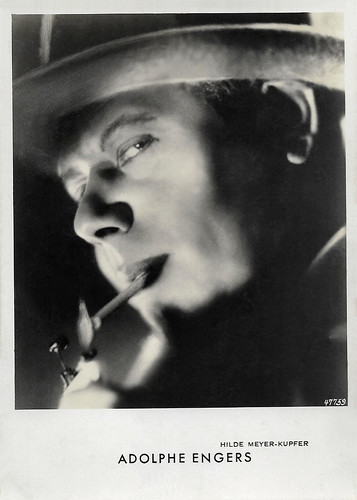
Dutch postcard, no. 47759. Photo: Hilde Meyer-Kupfer. Adolphe Engers.

Dutch film still for Ergens in Nederland (Ludwig Berger, 1940). Photo: Merkelbach / Filmex. The two soldiers in the boat are Jan de Hartog and probably Max Croiset. The man on the right is Matthieu van Eysden.
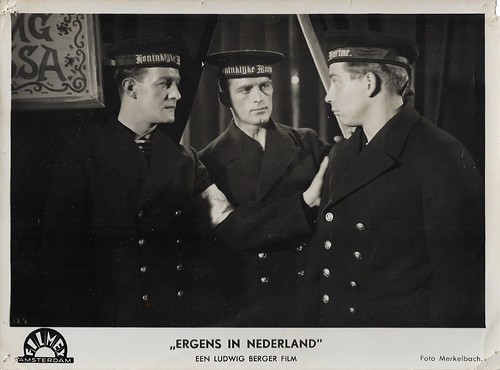
Dutch film still for Ergens in Nederland (Ludwig Berger, 1940). Photo: Merkelbach / Filmex. The man on the right is Jan de Hartog.

East-German postcard by VEB Progress Film-Vertrieb, Berlin, no. 2010, 1964. Retail price: 0,20 DM. Photo: Rob de Vries in De Overval/The Silent Raid (Paul Rotha, 1962).
A Dutch film par excellence for the first time
Rudolf (Rudi) Meyer was born in 1901 in Suhl, Germany. In the 1920s, he started his career in the film business through his uncle Erich Pommer, who was then head of the production at Decla. Rudi held various positions in the sector and in the early 1930s, he was the head of the export department of the Berlin production company Aafa Film A.G. of producer Gabriel Levy.
National Socialism in Germany drove the Jew Meyer out of the country in 1933. Jo Paerl, Aafa's Dutch representative, invited him to come to the Netherlands. Meyer and Levy worked for the Universal Film Agency in Amsterdam, which concentrated on buying Dutch, Belgian and French films.
At IMDb, Meyer’s first credit is as a production manager for the Belgian comedy, De wonderdokter/The Miracle Doctor (Jan Vanderheyden, 1936), starring Jan Cammans.
However, in 1934 Meyer had already started with Jo Pearl and Gabriel Levy the production company Holfi-Film (Hollandsche Film Productie). Their first production was the Dutch romantic comedy De kribbebijter/The Cross-Patch (1935) about a secretary (Dolly Mollinger) and the disinherited son (Frits van Dongen a.k.a. Philip Dorn) of a sour baron (Cor Ruys). For the direction, Meyer asked another emigrant, Hermann Kosterlitz, who later became famous in Hollywood as Henry Koster.
Both the critics and the public liked the film. Meyer’s second production was Amsterdam bij nacht/Amsterdam by Night (Alex Benno, 1936).
A real box-office hit was Meyer’s next production, Pygmalion (Ludwig Berger, 1937), an adaptation of the George Bernard Shaw play. The stars were Lily Bouwmeester as low-class flower seller Elisa, Johan De Meester as Professor Henry Higgins who mockingly offers to teach her how to speak properly, and Eduard Verkade as his friend and colleague Pickering. The part of Liesje Doeluttel made Bouwmeester into an instant star, leading to several more leading roles in Dutch films.
“For the first time since the beginning of Dutch film industry, one can speak without compunction of a Dutch film par excellence”, wrote the Catholic film magazine Filmfront: "For the first time, actors and actresses speak and act in a natural way. For the first time, sets and music are justified as living parts of a living whole. And what is most admirable in Berger’s film is the fact that he has managed to let the dialogue flow convincingly in the rhythm of the film".

Dutch postcard. Photo: Willem Coret, Den Haag. Eduard Verkade.
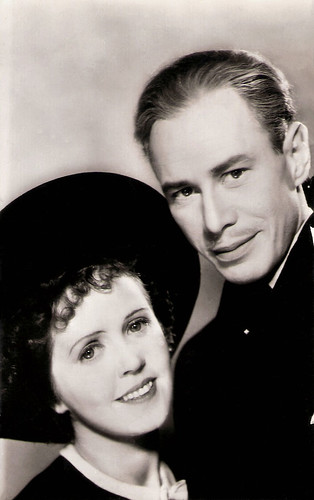
Dutch promotion card by Cinema Odeon, Den Haag. Photo: Neerlandia. Lily Bouwmeester as Judy and Paul Storm as Vadertje Langbeen in Vadertje Langbeen/Daddy Long Legs (Friedrich Zelnik, 1938).
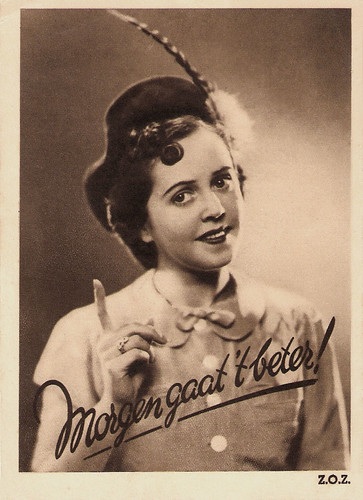
Dutch postcard by Colosseum Theater, Rotterdam. Photo: Neerlandia-Filmex. Lily Bouwmeester in Morgen gaat het beter/Tomorrow It Will Be Better (Friedrich Zelnik, 1939).
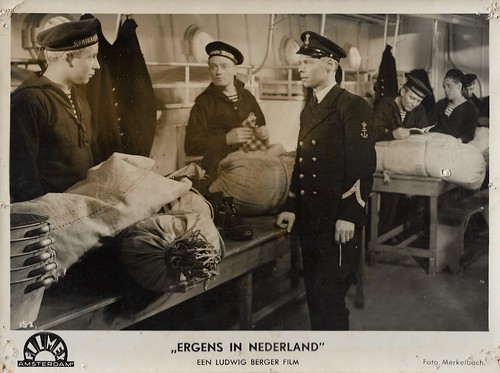
Dutch film still for Ergens in Nederland (Ludwig Berger, 1940). Photo: Merkelbach / Filmex. The man on the left is Jan de Hartog and the one on the right Max Croiset.

Dutch film still for Ergens in Nederland (Ludwig Berger, 1940). Photo: Merkelbach / Filmex. The man on the left is Jan de Hartog.
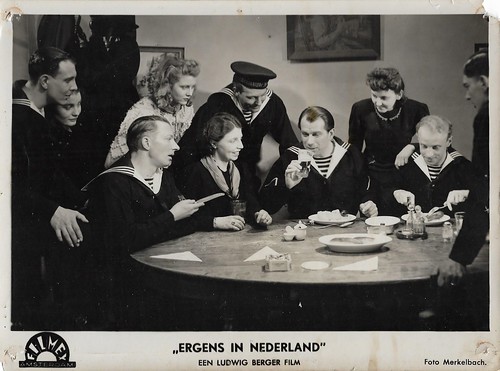
Dutch film still for Ergens in Nederland (Ludwig Berger, 1940). Photo: Merkelbach / Filmex. Sitting in the middle is Jan de Hartog and the one on the right Matthieu van Eysden.
Shifting from light-hearted entertainment to more serious social subjects
Pygmalion was a hit and the next year, Rudi Meyer duplicated the success with Vadertje Langbeen/Daddy Longlegs (Friedrich Zelnik, 1938) based on Jean Webster's 1912 novel 'Daddy Long Legs'. Again Lily Bouwmeester played the lead as Judy Aalders, an orphan girl longing for a family of her own. Her co-star was Paul Storm as Judy’s anonymous benefactor of whom she only saw a long shadow.
Meyer asked émigré director Friedrich Zelnik (later Fredric Zelnik) again to direct his next project, Morgen gaat 't beter!/Tomorrow It Will Be Better (Friedrich Zelnik, 1939), based on a novel by Annemarie Selinko. Lily Bouwmeester now played a not too smart schoolgirl who has to provide for herself during the crisis of the 1930s.
That same year, Meyer also produced De spooktrein/The Ghost Train (1939), directed by another prominent émigré director, Karel Lamač. A group of travelers finds themselves stranded for the night at a deserted train station, which according to the old stationmaster, has been haunted for the last 20 years. The all-star cast included Jan Musch as the stationmaster, Fien de la Mar, and Adolphe Engers as a strange professor.
In 1939 Meyer also became a board member of the film distribution company Filmex. German director Ludwig Berger shot Ergens in Nederland/Somewhere in the Netherlands (Ludwig Berger, 1940), about the mobilisation and the Dutch navy. The stars were Lily Bouwmeester and the future bestseller author Jan de Hartog. Ergens in Nederland was just released in the Dutch cinemas when the Netherlands was conquered by the Nazis, who immediately banned the film.
Especially in the latter two films, a shift can be seen from a light-hearted sort of entertainment to more serious social subjects and current events. Meyer and Berger had planned to make a third film together but when war broke out, this plan never materialised.
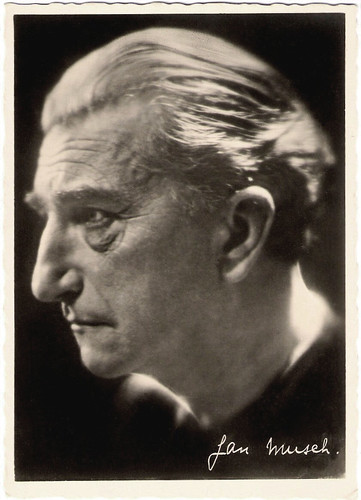
Dutch postcard by REB in the series Portrettengalerij no. 105. Jan Musch.
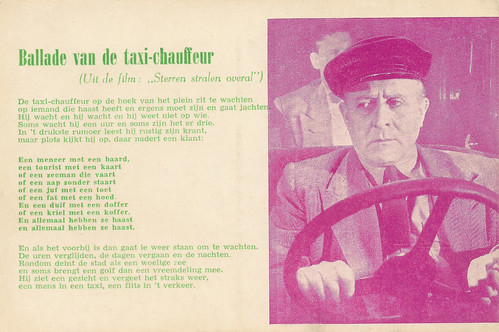
Dutch postcard by Editions Altona, Amsterdam, no. T 63. Photo: Johan Kaart in Sterren Stralen Overal/Stars Twinkle Anywhere (Gerard Rutten, 1953). Songtext of 'Ballade van de taxi-chauffeur'.
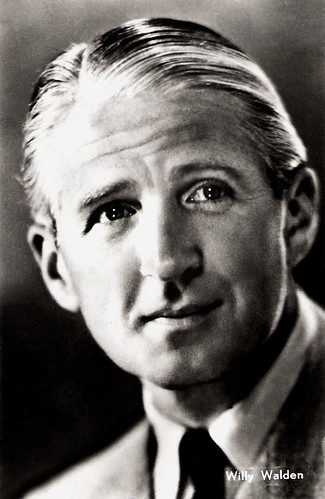
Dutch collectors card. Willy Walden.
Dutch comedians Willy Walden (1905-2003) and Piet Muyselaar (1899-1978), a.k.a. the ladies Snip & Snap, were the stars of the Sleeswijk Revue which filled the biggest theatres of the Netherlands between 1937 and 1977. The duo also starred together on TV and in the film Sterren stralen overal (1953).
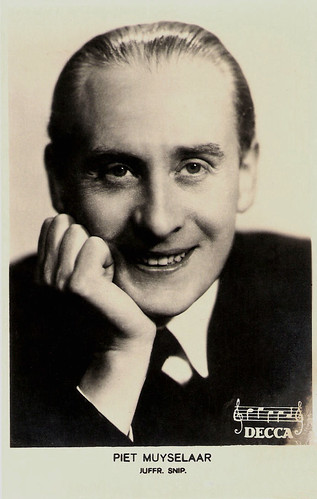
Dutch postcard by Uitg. Handelsonderneming Triëm, Utrecht. Photo: Decca. Piet Muyselaar.
The second most successful Dutch film of all time
Rudolf Meyer spent the first four years of the occupation (1940 to 1944) relatively safely in the Netherlands, protected by his marriage to a non-Jewish woman. In 1944 the Germans deported him to the Auschwitz extermination camp, which, however, he survived reasonably intact.
Upon his return to the Netherlands, he resumed his old profession as a film distributor for Filmex. He was responsible for the release of Roma, città aperta/Rome Open City (1945) and Paisa (1946), both directed by Roberto Rossellini. He scored a big hit with the Sissi trilogy (Ernst Marischka, 1955-1957).
As a producer, he returned to the cinemas with Sterren stralen overall/Stars twinkle everywhere (Gerard Rutten, 1953). Johan Kaart played in the film a struggling Dutch cab driver who wants to emigrate with his family to Australia. The film attracted one and a half million visitors - partly due to the guest appearance of the immensely popular revue duo Piet Muijselaar and Willy Walden (Snip & Snap).
An even bigger box office hit was the comedy Fanfare (1958), directed by documentary film maker Bert Haanstra and starring Hans Kaart, Albert Mol, and Andrea Domburg. After a fight, the brass band (fanfare in Dutch) in the fictitious village of Lagerwiede splits up into two separate bands. They both want to win a contest and will do anything to prevent the other band from winning it. The film was visited by 2,636,000 people, which made Fanfare the second most successful Dutch film of all time.
The follow-up film, De Zaak M.P./The Manneken Pis Case (1960), also directed by Bert Haanstra and starring Albert Mol, was a disappointing flop, both critically and commercially. The quite silly comedy had been produced jointly by Haanstra and Meyer.
Much better was Meyer’s next production, the war thriller De Overval/The Silent Raid (Paul Rotha, 1962), starring Rob de Vries, Kees Brusse, and Yoka Beretty. In 1944, resistance-fighter Bakker (Rob de Vries, who had been a real resistance fighter during the war) gets sent to a prison in Leeuwarden by the Gestapo. There he and other resistance-fighters are about to be rescued in a giant prison escape by their companions.
Like no other, Meyer knew what the public wanted and he could offer it to them: without making too many concessions to quality, but also without too much experimentation.
A sensation was the documentary Mensen van morgen/People of Tomorrow (Kees Brusse, 1964), a portrait of a new generation. Young people talked frankly to director Kees Brusse about love, faith, sex, and society. Two years later followed a German version, Menschen von Morgen - Geständnisse vor der Kamera (1966), also directed by Kees Brusse. It was Meyer's final film.
Rudi Meyer passed away in 1969 in Amsterdam. He was 68.
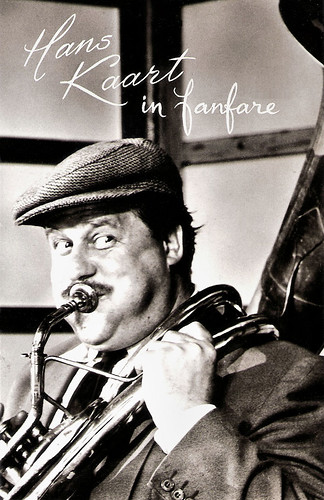
Dutch postcard by Uitg. Takken, Utrecht, no. 3796. Photo: Jutka Mol-Rona / Sapphire Film Productie. Hans Kaart in Fanfare (Bert Haanstra, 1958).
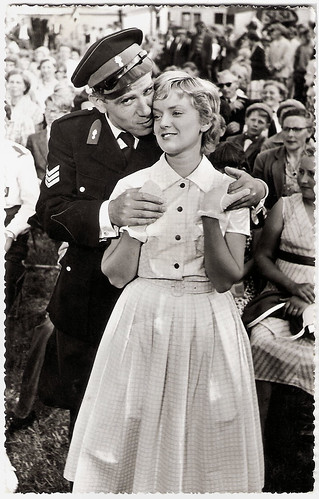
Dutch postcard by Int. Filmpers (IFP), Amsterdam, no. 1920. Photo: Ineke Brinkman and Wim van den Heuvel in Fanfare (Bert Haanstra, 1958).
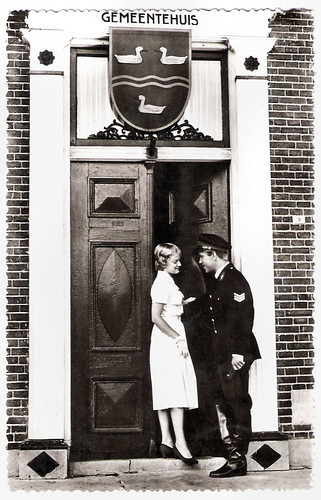
Dutch postcard by Int. Filmpers (IFP), Amsterdam, no. 1932. Photo: Ineke Brinkman and Wim van den Heuvel in Fanfare (Bert Haanstra, 1958).

Dutch postcard by Uitg. Takken, Utrecht, no. 3792. Photo: Jutka Mol-Rona / Sapphire Film Productie. Andrea Domburg in Fanfare (Bert Haanstra, 1958).

Dutch postcard by Uitg. Takken, Utrecht, no. 3793. Photo: Jutka Mol-Rona / Sapphire Film Productie. Herbert Joeks in Fanfare (Bert Haanstra, 1958).
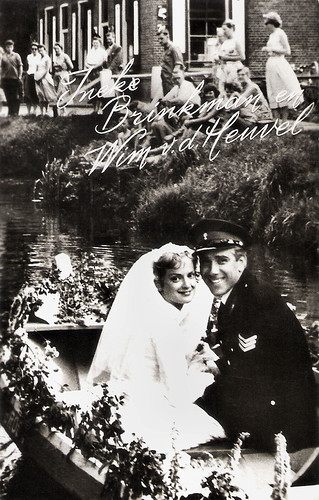
Dutch postcard by Uitg. Takken, Utrecht, no. 3794. Photo: Jutka Mol-Rona / Sapphire Film Productie. Ineke Brinkman and Wim van den Heuvel in Fanfare (Bert Haanstra, 1958).
Sources: Chip Douglas (IMDb), Eye (Dutch), Wikipedia (German), and IMDb.
No comments:
Post a Comment